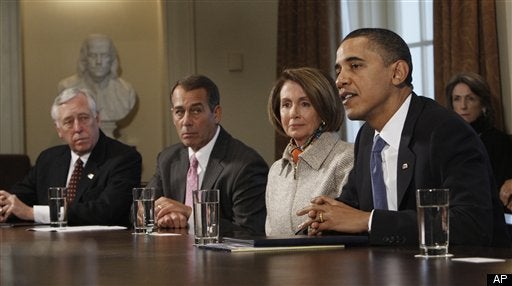
Congressional Democrats have done a bit of homework and found, not so surprisingly, that the House has a long history of using parliamentary tactics to avoid tough votes. The lack of courage exhibited by today's members, it turns out, is nothing special.
The first time that the chamber used what's known as a "deeming resolution" -- the mechanism Democrats are leaning toward using to pass the Senate health care bill through the House -- was March 16, 1933.
Then, as now, it involved a bill that had little support in the chamber among individual Democrats, but all of them knew they had to pass it. Very few Democrats want to vote for the Senate version of health care reform, but most are okay with it as long as it's amended through reconciliation.
Less than two weeks into FDR's first 100 days, Congress needed to raise its debt ceiling, a ritual vote that hasn't gotten any easier for the majority party in the intervening 77 years -- and is still political fodder for partisan opponents.
Instead of voting on the underlying Senate bill to raise the debt ceiling in 1933, the House voted on Resolution 63, which stated that "immediately upon the adoption of this resolution the bill H.R. 2820, with Senate amendments thereto, be, and the same hereby is, taken from the Speaker's table to the end that all Senate amendments be, and the same are hereby, agreed to."
In other words, it was deemed passed and sent to the president for his signature.
There was some confusion on the House floor about the process.
"Mr. Speaker, a parliamentary inquiry," said Rep. Bertrand Snell (R-N.Y.), according to a transcript unearthed by Democrats. "Mr. Speaker, it would seem to me that if we adopt this resolution that ends the bill and there is no further vote on the bill itself."
"That is correct," Speaker Henry Rainey (D-Ill.) told Snell.
"I understood the gentleman from Alabama to say that we would then vote for or against the bill," responded Snell.
That gentleman then corrected himself. "No; the gentleman from Alabama was mistaken," said Rep. John McDuffie (D-Ala.).
"If we adopt this resolution, we pass the bill," Snell clarified.
Yes, said McDuffie. "We have then concurred in the Senate amendment, and, therefore, the bill is passed, so far as the House is concerned," he said.
"And there is no other vote on the bill," said Snell.
"No other vote on the bill, as I understand it," said McDuffie.
"That is correct," chimed in the Speaker.
Rep. Eric Cantor (R-Va.), the second-ranking Republican in the House, said modern-day Democrats are using "gimmicks" to bend the rules. Republicans, however, have often made use of the deeming resolution themselves -- 36 times in 2005 and 2006, when they controlled the lower chamber. Democrats used deeming resolutions 49 times in 2007 and 2008.
The GOP wasted no time using it as soon as they took the majority in 1948. This time it was left to former Speaker Sam Rayburn (D-Texas), who would retake the gavel in 1949, but was briefly in the minority, to wonder about the maneuver.
The issue again was the debt limit.
"Mr. Speaker, a parliamentary inquiry," ventured Rayburn.
